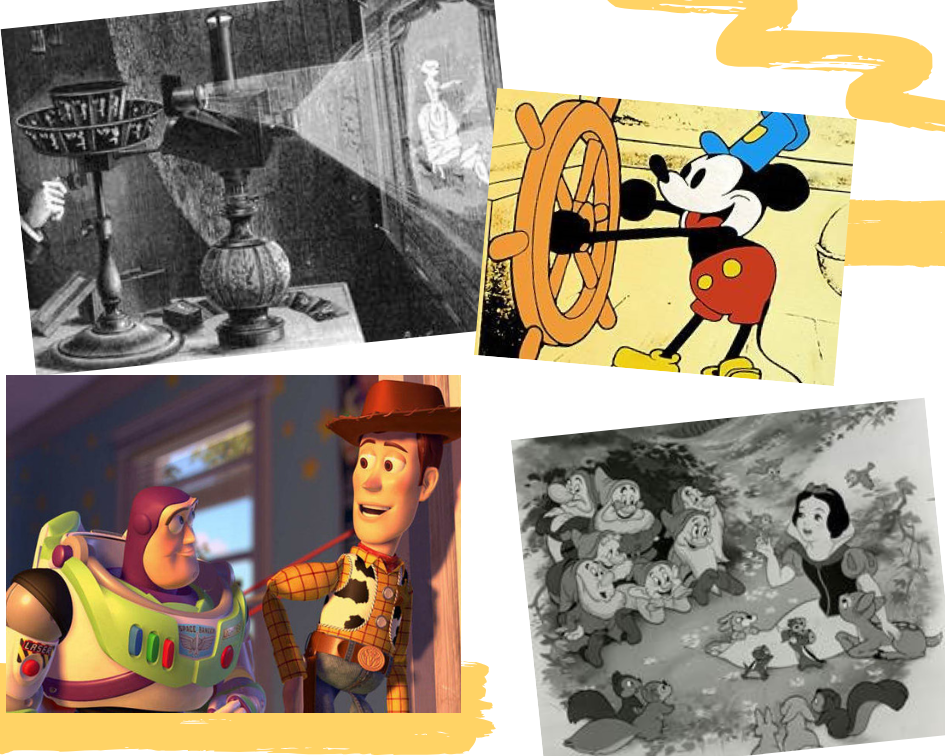The history of animations can technically date back to the Paleolithic period when shadow play, using hands, was projected on a screen and used for storytelling. It wasn’t until 1888 when Charles-Émile Reynaud, a French scientist, invented the praxinoscope that animations were first seen on film. The device was used to project strips of hand-painted pictures onto a screen. Over 150 years have gone by and animations have come a long way in technological advancements, starting with a simple black and white 2D drawing and moving on to high-quality 3D computer-generated images.
In discussing the history, concept, and progression of animations, let’s first begin explaining the differences between 2D and 3D essentials and how artists later started to use the combined effects of both elements for storytelling. In 2D animation we have a two-dimensional platform that contains a flat picture, offering only one perspective. In contrast, 3D animation involves a three-dimensional platform and offers multiple perspectives, like in real life. Overall, there are variances between the perception of space and a character’s movement.
Beginning in the early 1900’s various production techniques including puppet, silhouette, clay, and hand-drawn images were used for producing animations. During this time some popular characters that animations aided in producing were Felix the Cat, Bonzo the Dog, and Mickey Mouse. The popular cartoon Tom and Jerry was later created in 1940.
There are so many cartoon characters to name that we may very well be here all day. Instead, let’s look at some primary techniques of 2D animation that eventually led to where we are today. In 1937, Walt Disney created the first full-length cel animation for Snow White and the Seven Dwarves. This popular technique was made possible by hand drawing each frame on a transparent medium and overlaying them on top of fixed backgrounds or photographs. A total of 24 frames were used per second of animation.
As we began to advance, animators took advantage of new computer graphics technology. The movie Westworld, produced in 1973 was an American science fiction Western thriller and was the first feature film to incorporate digital image processing. The digital effect is now a routine process that we refer to as pixelization. Following this, the development of computer graphics animations became much more realistic. Toy Story was produced in 1995 and was the first computer animated feature length film.

Stepping beyond multiple hand-drawn images would make you think that computer graphics allowed for quicker production time. However, a great deal of work still goes into the production of animations. The making of Toy Story comprised over 800,000 machine-hours and the help of eight different departments. In addition, with the notion of wanting to advance so far, we often run into limitations. At the time, the producers of Toy Story were unable to give the character Andy a dad. Why? Simply because the technology during this time did not allow for another character to be added. It would have been too complex and extremely costly.
Fast track to today and we see that animations are more profitable, and the previous setbacks have been eliminated as companies are able to pour more time and money into improvements. Not only are 3D animations seeing success but 2D animations as well. For example, the cartoon show The Simpsons and SpongeBob SquarePants are made possible thanks to 2D animations.
Today, many companies including us like to use combined forms of 2D and 3D elements to share a vision. So, how do we bring stories to life? The process begins with a concept and storyboards, followed by modeling a scene, layout and animation, finally rendering the final output. This is a simplified version of the work that goes into producing an animation.
Animations have taken a large leap forward in our digital age as we convey stories that allow the audience to relate and empathize with the characters involved. Looking back at the history of animations, does a favorite animated film or television show come to mind that you used to enjoy growing up?